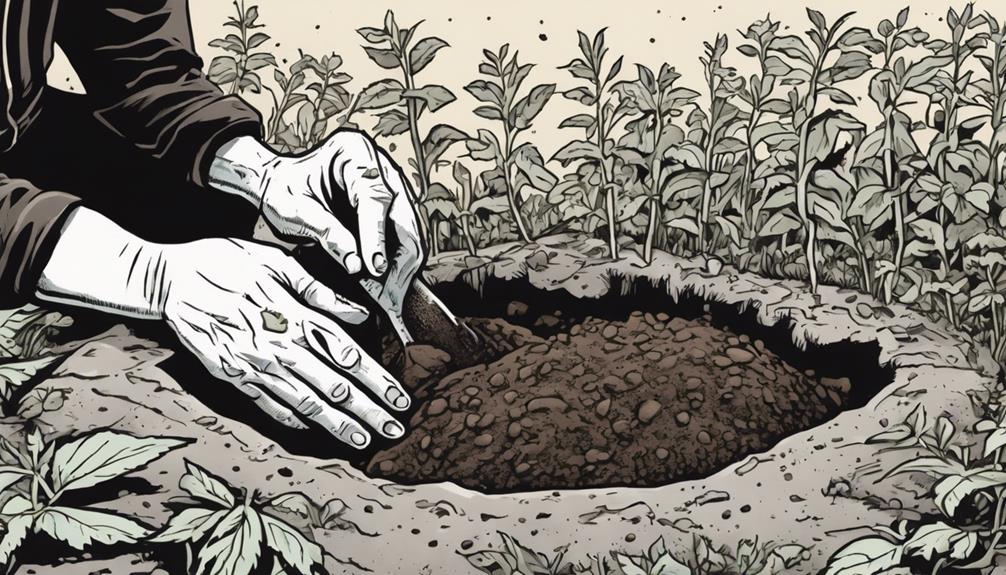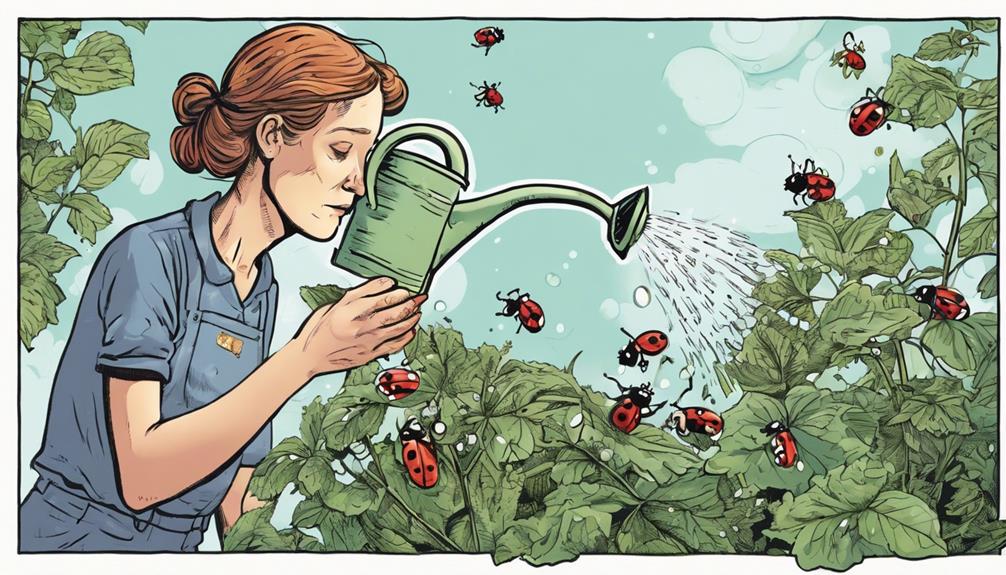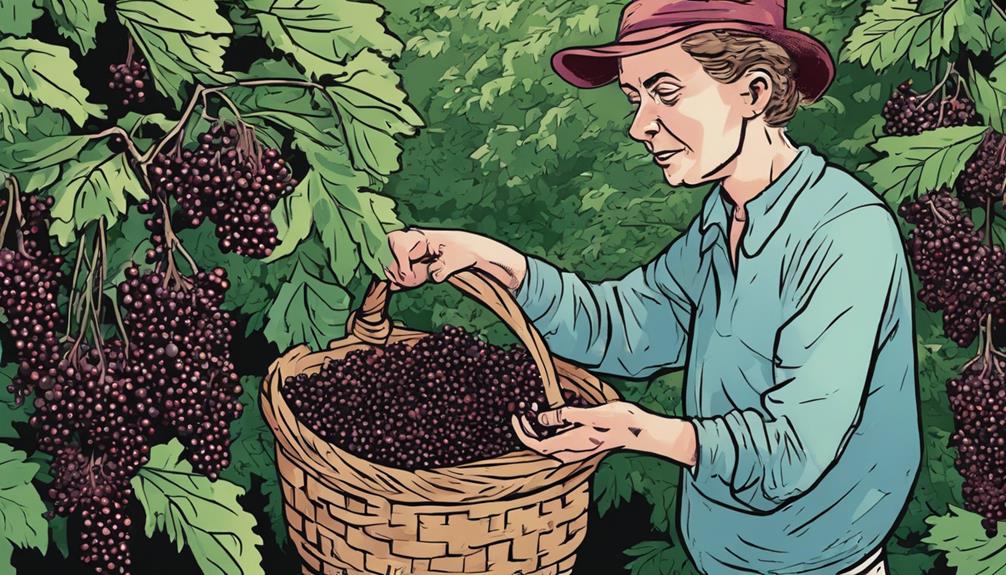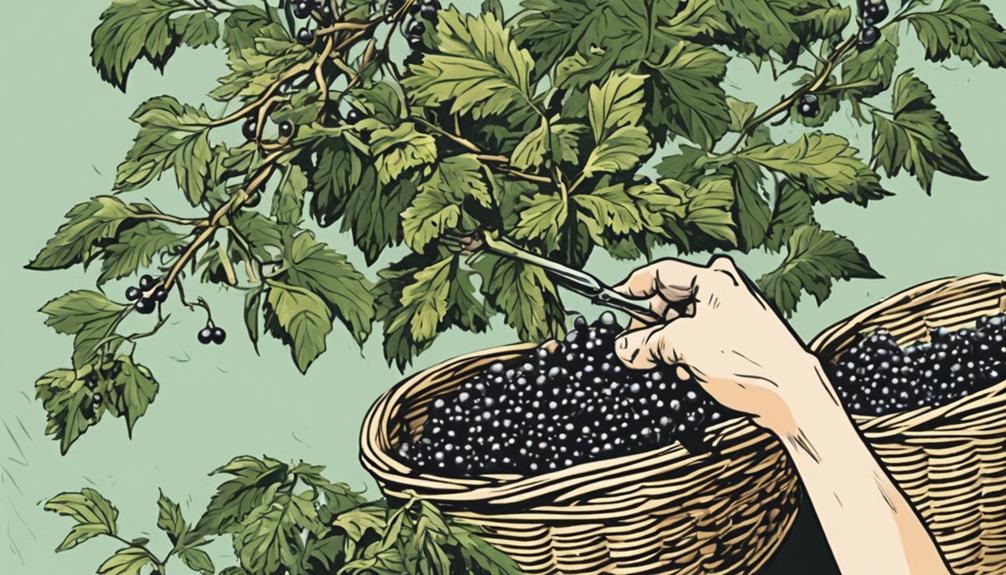Caring for elderberry plants is a delicate balance that can significantly impact their growth and fruit production. Optimal location, precise pruning, and appropriate nourishment are essential steps.
Beyond these basics, there are additional strategies that can elevate your elderberry care routine. Discover how to maximize the potential of your elderberry plants for outstanding growth.
To optimize elderberry growth, ensure they're planted in well-drained soil with full sun exposure. Regular pruning encourages airflow and light penetration, vital for health and fruiting. Fertilize with a balanced, organic fertilizer in early spring. Mulching conserves moisture and suppresses weeds. Monitor for pests and diseases, treating them promptly to prevent spread.
Planting

When planting Elderberry, consider the ideal timing for planting, the preparation of planting holes, and the importance of trellising for support.
Ensuring proper spacing between vines, installing root stock, and staking new vines are key points to focus on for successful growth.
These steps will set a strong foundation for your Elderberry plants to thrive and yield bountiful fruit.
When to plant Elderberry
Plant elderberries in fall or early spring. Fall planting helps roots grow strong during the off-season. This way, they start strong in spring without heat stress.
Early spring planting gives plants time to get used to before growing season. This helps them grow well and make lots of fruit.
Choose the right time to plant for healthy elderberries.
Prepping holes & trellising
To plant elderberry plants, dig holes 2-3 times wider than the root ball and the same depth. Add compost to the soil to help with drainage and growth.
For trellising, especially in windy places, give support right when you plant to stop root damage and make sure the plant stays upright. It’s important to space elderberry plants and trellises well for good growth and easy care. Here are the key points:
| Aspects | Elderberry Plants | Trellising |
|---|---|---|
| Hole Size | 2-3 times wider than root ball | – |
| Soil Amendment | Add compost | – |
| Proper Spacing | Needed for growth | Needed for support |
Spacing between vines
Space elderberry plants 6 to 10 feet apart. This spacing helps them grow without crowding, lets air move around freely, and cuts down on disease by keeping the area less humid.
Good air movement is crucial. It stops diseases by lowering moisture around the plants.
Each plant gets enough sunlight and soil nutrients with proper spacing. This means less competition and healthier growth for each elderberry shrub.
Installing root stock and staking new vines
When setting up elderberry root stock and adding stakes for new vines, make sure the soil drains well and is rich. The soil pH should be between 5.5 and 6.5 for the best growth. Plant the new vines at the same depth they were in their nursery container to avoid root problems.
Staking new elderberry vines helps them stay upright, protecting them from wind or the weight of their fruit. Use bamboo stakes or trellises to support and direct the young vines upwards. This encourages a strong root system and upright growth for better sun exposure.
| Elderberry Planting Tips | |
|---|---|
| Soil Conditions | Well-drained, fertile soil with pH 5.5-6.5 |
| Planting Depth | Same as nursery container depth |
| Staking Materials | Bamboo stakes, trellises |
Pruning & Training
When it comes to pruning and training your elderberry plants, the first year is important for establishing their growth pattern. You should focus on initial training of the vines, ensuring they grow in the desired direction.
As the plants mature, ongoing annual pruning will help maintain their shape and promote best fruit production. Remember to trim away any suckers and excess growth to keep your elderberries healthy and productive.
First year pruning and training vines
To help your elderberry vines grow well and give you lots of fruit, it’s important to prune and train them right in their first year. Here’s how you can set them up for success:
- Cut off any dead, damaged, or weak stems. This helps the plant grow strong and lets air move around it better.
- Trim side branches to encourage growth outwards. This makes the vine more open and helps it produce more fruit.
- Choose the healthiest canes to shape the vine. This builds a strong base for the plant’s growth. Don’t cut too much in the first year so the plant can work on growing its roots.
Ongoing annual pruning for shape and fruit production
To keep your elderberry shrubs healthy and full of fruit, it’s best to prune them every year during the late winter or early spring. Pruning is essential. Focus on cutting off dead, damaged, or thin stems. This helps more air and sunlight reach the inside of the shrub.
Cut older wood to make room for new, fruit-bearing branches. Proper pruning keeps your shrub the right shape and size, stops it from getting too crowded, and leads to more fruit. Annual pruning boosts growth and fruit.
Trimming away suckers and excess growth
Trim your elderberry shrubs by cutting off roots that grow shoots and any extra branches. This helps control the plant’s shape and boosts fruit growth.
Here’s how:
- Find Shoots: Search for new growth from the plant’s roots. These are shoots to remove.
- Cut Carefully: Use sharp shears to remove shoots and extra branches.
- Boost Fruit Growth: Removing shoots and extra growth helps the plant focus on making more fruits and flowers.
This keeps your elderberry plant healthy and productive.
Pollination & Fertilization
To guarantee peak fruit production, elderberry plants rely on cross-pollination, requiring multiple shrubs within 60 feet of each other.
While not mandatory, fertilization can boost fruit growth and overall plant vigor, with a 10-10-10 fertilizer mix in spring providing essential nutrients.
Following these practices supports abundant fruit production, guaranteeing a fruitful harvest and robust elderberry shrubs.
Self-pollinating flowers
Elderberry plants have flowers that pollinate themselves. This means they can make fruit on their own, which is great for gardeners. Here’s why this is good:
- Self-pollinating: Elderberries don’t need other plants or bees to make fruit. This makes growing them easy.
- More fruit: If you have several elderberry plants close to each other, they can still cross-pollinate. This can lead to even more fruit.
- Reliable fruit-making: Elderberries can make fruit even when there aren’t many bees around because they can pollinate themselves.
Knowing that elderberry flowers can pollinate themselves helps you plan your garden better and expect a good amount of fruit without worrying about bees.
Recommended organic fertilizers and timing
Use compost or manure on your elderberry plants in early spring.
Organic fertilizers are better than synthetic ones because they keep the soil healthy and give your plants important nutrients.
Make sure to fertilize at the right time to match when the plants grow and need these nutrients the most.
Adding organic fertilizers regularly helps elderberries produce more fruit and grow stronger.
Use these fertilizers in your garden to help your elderberry plants do well and give you lots of fruit, all while sticking to natural gardening methods.
Watering & Pest Management

To guarantee your elderberry plants thrive, it’s critical to understand their watering needs based on your region’s climate. Proper watering practices can help prevent issues like dehydration during hot, dry spells.
Additionally, implementing organic pest management techniques is essential to protect your elderberries from common pests like aphids and spider mites.
Watering needs and schedule based on region
Make a watering plan that fits your area to help your elderberry plants grow well.
- Change how often you water based on how much it rains where you live.
- Check the soil to make sure your elderberries have enough water.
- Think about using drip irrigation or soaker hoses to keep the soil moist without making the leaves wet.
Identifying and controlling common pests organically
To keep your elderberry plants safe from pests organically, make sure they get the right amount of water. For aphids, bring in ladybugs or spray with water and dish soap.
Fight spider mites by making the air more humid around your plants and using neem oil sprays. To stop elderberry borers, cut off and get rid of sick plant parts. Don’t plant new elderberries close to ones that are infested.
Check your plants often for pests and act fast to avoid big damage. Using these organic methods helps protect your elderberries and keeps your garden eco-friendly.
Diseases & Winter Care
To make sure your elderberry plants stay healthy, it’s important to be vigilant against common diseases like powdery mildew and bacterial canker. Proper winter care measures, such as mulching and pruning in late winter, can protect your elderberries from harsh temperatures and disease.
Preventing and managing diseases
To keep elderberry plants healthy and free from disease, follow these steps:
Ensure good air flow: Good air around your elderberry plants stops fungal diseases. Don’t let plants get too crowded and cut them back to keep air moving.
Check plants often: Look for signs of disease, like leaves changing color or odd growths, and act quickly to stop diseases from spreading.
Use safe fungicides: Choose safe, organic fungicides for edible plants to control fungal diseases in elderberries, keeping your garden safe from harsh chemicals.
Winter protection methods
To keep your elderberry plants healthy in winter, you need to follow some key steps.
Apply dormant sprays in late fall to protect against diseases like powdery mildew and cankers.
Use mulch around the plants to keep roots warm and prevent the soil from moving due to frost.
Prune the plants in late winter to get rid of dead or sick branches, which helps the plant grow well.
Make sure the soil drains water properly to avoid root problems.
Protect your plants from strong winter winds by placing them near a natural barrier or setting up burlap screens.
These actions will help your elderberry plants stay strong through winter and grow beautifully when warmer days return.
Harvesting & Storage

When your elderberries reach best ripeness, it’s time to start harvesting them in quantities that suit your needs.
Gather bunches carefully to make sure you collect the fruits without damaging them.
After harvesting, make sure to store your elderberries using appropriate methods to keep them fresh for future use.
When possum grapes reach peak ripeness
Possum grapes, often called elderberries, are best in mid-August to mid-September. They turn deep purple-black and taste sweet. Here’s how to pick and keep them:
- Pick Carefully: Use scissors or pruning shears to carefully remove ripe possum grapes without hurting the plant.
- Keep Cool: Put the elderberries in the fridge right away to keep them fresh.
- Freeze for Later: Freeze the grapes if you want to keep them for a long time.
Harvesting quantities and bunches
Pick elderberries when they’re fully ripe and come off the stems easily with a light pull.
Think about how many elderberries you need for your use. Collect them in bunches or clusters to make picking easier. You might get several pounds to bushels of elderberries, depending on your plant size and yield.
Since elderberries don’t all ripen at the same time, harvesting in multiple rounds is often needed. Picking ripe elderberries in bunches makes the harvest more efficient and lets you enjoy these tasty and healthy fruits.
Storing and preserving the harvest
After picking your ripe elderberries, you need to store them right so you can keep their taste and health benefits for longer.
- Refrigerate your elderberries if you plan to use them soon. This keeps them fresh.
- Freeze elderberries for keeping them longer. Spread them on a sheet to freeze, then put them in a freezer bag.
- Dry elderberries completely before storing. Use a dehydrator or air-dry them until they’re dry.
These methods let you enjoy your elderberries in foods like jams, jellies, syrups, wines, or tinctures for up to a year, keeping their good taste and nutrients.
Companion Plantings

When planning companion plantings for your elderberry patch, consider beneficial ground covers like clover or vetch to help retain moisture, suppress weeds, and improve soil structure.
Trellising vines such as grapes or raspberries near your elderberries can provide support, create vertical interest, and maximize space efficiency in the garden.
These strategic pairings not only enhance the aesthetics of your garden but also contribute to a healthier, more balanced ecosystem for your elderberry plants to thrive.
Beneficial ground covers and trellising vines
Choose comfrey, yarrow, and dill as companion plants for elderberry bushes. They help by adding nutrients, attracting pollinators, and keeping pests away.
- Comfrey has deep roots that pull up minerals, improving soil for elderberries.
- Yarrow attracts bees and butterflies, increasing fruit yield.
- Dill smells good and keeps harmful insects away from elderberries.
Regional Differences

When caring for elderberry plants, it’s important to adapt your approach based on the growing zones and climate of your region. Adjusting care practices to suit the specific conditions of your area can lead to healthier plants and better yields.
Understanding how regional differences impact elderberry growth will help you achieve best results in your cultivation efforts.
Adjusting care by growing zones and climate
To make sure your elderberry plants grow well and give lots of fruit, it’s important to change how you care for them based on where you live. Here are three main things to think about:
- Know your growing zones: Elderberries do best in USDA hardiness zones 3 to 9. They can handle different weather and soil in these areas.
- Change how you care for them: Use different care methods depending on your area’s weather, how much sun they get, and what the soil is like. This helps your plants stay healthy and produce more fruit.
- Think about the climate: The weather where you live affects how elderberries grow, flower, and make fruit. Adjusting your care to fit your area’s rain, humidity, and other environmental factors helps your plants do well.
Frequently Asked Questions
Do You Need 2 Elderberry Bushes to Get Fruit?
Yes, you need 2 elderberry bushes for fruit. Cross-pollination between different bushes is crucial for successful fruit production. Planting multiple bushes within 60 feet enhances yield. Having varied varieties increases genetic diversity and guarantees better fruiting.
Where Is the Best Place to Plant Elderberry?
For the best place to plant elderberries, choose a spot with full sun and moist, humusy soil. Guarantee proper spacing, provide regular watering, and consider annual fertilization. Prune in late winter or early spring to maintain health and increase fruit yield.
Does Elderberry Come Back Every Year?
Yes, elderberry comes back every year. Its perennial nature guarantees a return from established roots. With proper care like pruning, watering, and soil maintenance, you can enjoy its vibrant foliage and fruit production annually.
Do Elderberry Plants Spread?
Yes, elderberry plants spread through root suckers, forming dense thickets if not managed. Regular pruning is essential to control their spread. Keep a close eye on them to prevent uncontrollable expansion and maintain your garden’s balance.
